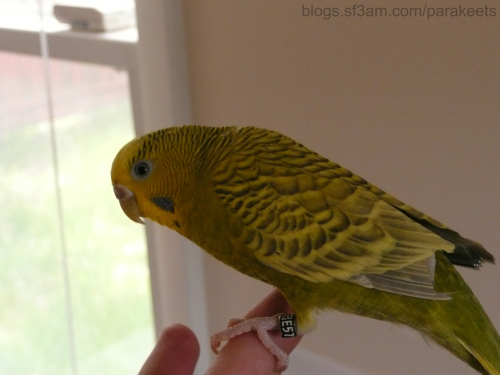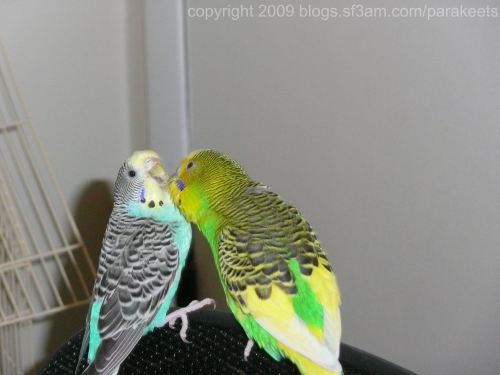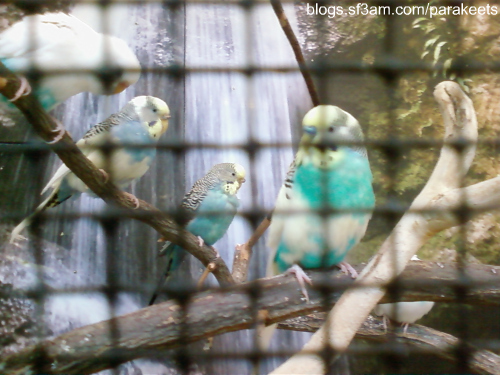by Jessica
May 2009
Tag: photos
Jessica with Striker
Striker and Belle on my arm
May 2009
These two are very adventurous–Striker (the green one) is very bold and brave, ready to meet new people, try new foods, and explore new rooms in the house. Belle is very affectionate and trusting. Plus, when one goes exploring, the other one starts chirping loudly until he gets a response from the other one–and eventually they usually meet up after exchanging numerous geo-location chirps.
clipping your bird’s wings

[Update 4/18/2010: I have re-thought my views slightly on wing clipping with experience; you can read an updated opinion here.]
Birds like to fly–this can make them very interesting pets at times, but there are also times when they need to have their wings clipped. Summer is coming up, and if birds are going to come along for trips, you don’t want them flying away, plus they have to be ready with the latest look.
Many bird owners like to have their pet’s wings clipped so that they can’t fly away or into trouble, but of course you want to leave the bird enough feathers to flap a little with, which will be crucial for landing when they try to fly after the cut.
It’s a good idea to have a veterinarian or vet tech do the cutting for you the first time your bird(s) have wings clipped. Ask to see them do it–nice clinics will often allow you–and then you’ll have a good idea how to do it yourself.
After that you can buy the special stainless steel wing clipping scissors they sell at pet stores and use them with greater confidence.
It’s really a two-person job, so make sure you have a bird-friendly assistant to help hold your bird, and make sure you know where to cut the feathers on your particular species.
Birds respond to feathers being cut (in the right place, of course) much in the same way a person would respond to a haircut–which is to say, the process should not be painful. Of course, most birds like to move around and don’t like to be restrained, but make sure your assistant holds your pet firmly while you cut the feathers.
With preparation, the right tools, a good assistant and proper care, and a few minutes, your wing clipping should go smoothly and you and your bird should be ready for safer adventures together!
Grooming

Parakeets are highly social birds; they travel in enormous flocks sometimes in their native land of Australia; and in homes they are likely to form close bonds with one another, and often the humans in the house as well.
Grooming is often thought to be a social behavior; it not only helps clean those hard to reach places and feels good, but also conveys affection and status to the bird being groomed.
the parakeets at the Cleveland Botanical Garden

The Cleveland Botanical Garden is on the east side of Cleveland and is host to many beautiful varieties of plants, but it also houses a few very interesting animals. These include chameleons and finches, and also parakeets.
The parakeets greet visitors as they come in. They have a tall cage that allows plenty of flying, along with some real branches for perching and a painted waterfall background. This picture gives a good look at four of the five birds, although the cage bars prevent a totally clear view.
parakeets love millet
I always ask my birds “Which bird likes millet?” when I give it to them because the answer is–of course–all of them. Ava and Sparty, normally very shy, can be lured out of the cage as soon as they see Belle and Striker out there going to town on spray millet.
Of course they can’t have millet and other seed-based diet all the time. I feed them fruit pellets for the most part.
A photo of the four–sort of

Getting a portrait of all four birds at the same time can be a challenge, but in this photo you can see Sparty, Ava and Striker looking with one eye while Belle (the blue one) is just breaking out of her favored beak-in-feathers position. In an Ohio winter, everyone gets cold, even indoors–me and Jessica, and also the birds, especially Belle. She’s the one most likely to have puffed feathers during the colder months. Even being indoors can’t completely protect them from the elements as the birds’ cage is near a door. Since budgerigars are native to Australia, we have to be sensitive to temperatures with them–we even gave them a blanket that hangs from the top of their cage.
The four parakeets
Jessica and I got four parakeets last year, and we’ve been having so much fun with them ever since!
They’ve learned quite a bit in that time, and we’ve learned a great deal about birds. Our parakeets are very social and very affectionate animals.
The names of our parakeets are Striker, Belle, Ava and Sparty.





